相位展开技术的应用
- 格式:ppt
- 大小:994.50 KB
- 文档页数:32
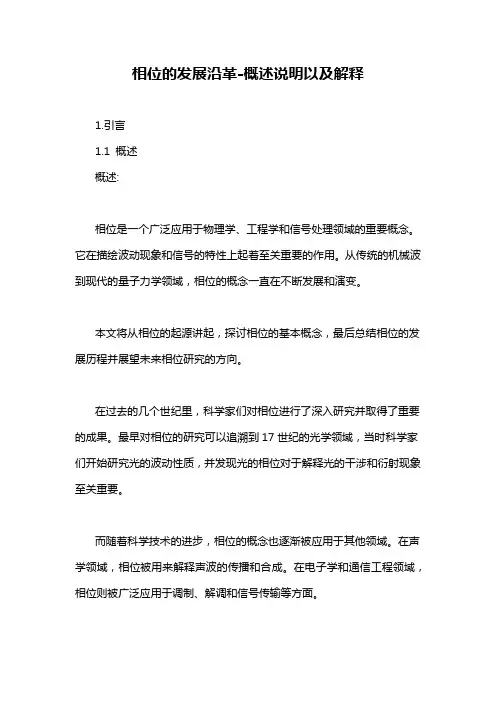
相位的发展沿革-概述说明以及解释1.引言1.1 概述概述:相位是一个广泛应用于物理学、工程学和信号处理领域的重要概念。
它在描绘波动现象和信号的特性上起着至关重要的作用。
从传统的机械波到现代的量子力学领域,相位的概念一直在不断发展和演变。
本文将从相位的起源讲起,探讨相位的基本概念,最后总结相位的发展历程并展望未来相位研究的方向。
在过去的几个世纪里,科学家们对相位进行了深入研究并取得了重要的成果。
最早对相位的研究可以追溯到17世纪的光学领域,当时科学家们开始研究光的波动性质,并发现光的相位对于解释光的干涉和衍射现象至关重要。
而随着科学技术的进步,相位的概念也逐渐被应用于其他领域。
在声学领域,相位被用来解释声波的传播和合成。
在电子学和通信工程领域,相位则被广泛应用于调制、解调和信号传输等方面。
相位的基本概念包括相位差、相位谱和相位修正等,这些概念赋予了相位在波动现象中的重要意义。
通过研究相位,我们可以更好地理解和描述波动的特性,并在实际应用中发挥重要作用。
本文将详细介绍相位的起源和基本概念,并总结相位的发展历程。
通过了解相位的发展沿革,我们可以更好地认识到相位在科学研究和工程实践中的价值,并对未来相位研究的发展方向有所展望。
在接下来的章节中,我们将逐步展开对相位的讨论。
首先,我们将从相位的起源开始,探讨相位是如何被科学家们发现和理解的。
然后,我们将详细介绍相位的基本概念,包括相位差、相位谱和相位修正等。
最后,我们将总结相位的发展历程,并展望未来相位研究的前景。
通过本文的阐述,我们希望读者能够更好地理解相位的意义和应用,并认识到相位作为一个重要概念在不同领域中的价值。
相位的发展沿革不仅是科学发展的一个缩影,也为未来的相位研究提供了重要的启示和方向。
1.2文章结构1.2 文章结构本文将按照以下结构来探讨相位的发展沿革:第二部分将介绍相位的起源以及相关的基本概念。
我们将探讨相位概念最早出现的背景和原因,并介绍最早的相位理论模型。
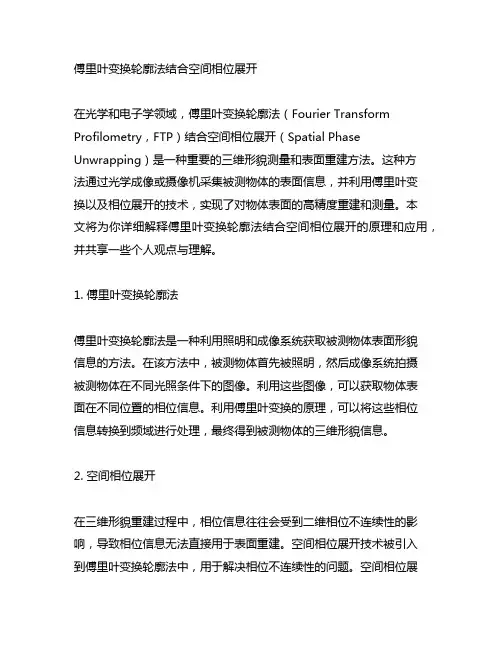
傅里叶变换轮廓法结合空间相位展开在光学和电子学领域,傅里叶变换轮廓法(Fourier Transform Profilometry,FTP)结合空间相位展开(Spatial Phase Unwrapping)是一种重要的三维形貌测量和表面重建方法。
这种方法通过光学成像或摄像机采集被测物体的表面信息,并利用傅里叶变换以及相位展开的技术,实现了对物体表面的高精度重建和测量。
本文将为你详细解释傅里叶变换轮廓法结合空间相位展开的原理和应用,并共享一些个人观点与理解。
1. 傅里叶变换轮廓法傅里叶变换轮廓法是一种利用照明和成像系统获取被测物体表面形貌信息的方法。
在该方法中,被测物体首先被照明,然后成像系统拍摄被测物体在不同光照条件下的图像。
利用这些图像,可以获取物体表面在不同位置的相位信息。
利用傅里叶变换的原理,可以将这些相位信息转换到频域进行处理,最终得到被测物体的三维形貌信息。
2. 空间相位展开在三维形貌重建过程中,相位信息往往会受到二维相位不连续性的影响,导致相位信息无法直接用于表面重建。
空间相位展开技术被引入到傅里叶变换轮廓法中,用于解决相位不连续性的问题。
空间相位展开通过一系列的算法和数学方法,将相位信息从二维空间展开到三维空间,实现了对相位信息的连续性重建,从而得到了被测物体表面的精确形貌信息。
3. 应用与展望傅里叶变换轮廓法结合空间相位展开在工业制造、医学影像、文物保护等领域有着广泛的应用前景。
在工业制造领域,该方法可以用于零件表面质量的在线检测和三维形貌的快速重建;在医学影像领域,该方法可以用于患者骨骼和组织的三维重建和量化分析;在文物保护领域,该方法可以用于文物表面的三维数字化重建和保护。
随着光学成像和图像处理技术的不断发展,傅里叶变换轮廓法结合空间相位展开将会有着更加广阔的应用前景。
在个人看来,傅里叶变换轮廓法结合空间相位展开是一种非常有前景和潜力的三维形貌测量和表面重建方法。
它不仅在科学研究中有着重要的应用,也在工业生产和文化遗产保护等领域有着广泛的应用前景。
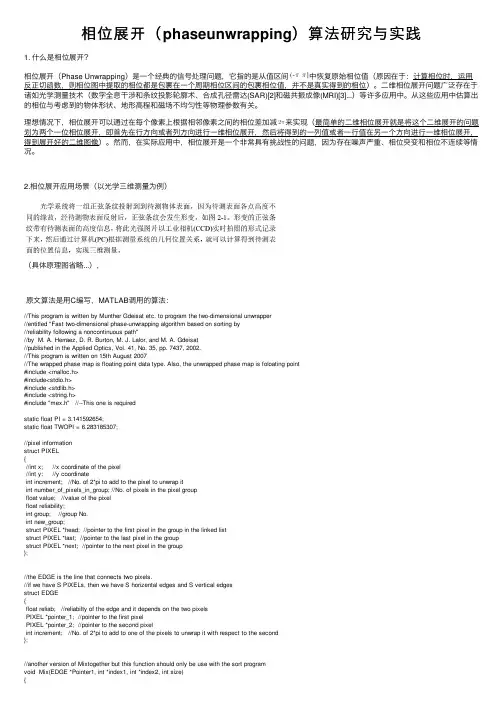
相位展开(phaseunwrapping)算法研究与实践1. 什么是相位展开?相位展开(Phase Unwrapping)是⼀个经典的信号处理问题,它指的是从值区间中恢复原始相位值(原因在于:计算相位时,运⽤反正切函数,则相位图中提取的相位都是包裹在⼀个周期相位区间的包裹相位值,并不是真实得到的相位)。
⼆维相位展开问题⼴泛存在于诸如光学测量技术(数字全息⼲涉和条纹投影轮廓术、合成孔径雷达(SAR)[2]和磁共振成像(MRI)[3]...)等许多应⽤中。
从这些应⽤中估算出的相位与考虑到的物体形状、地形⾼程和磁场不均匀性等物理参数有关。
理想情况下,相位展开可以通过在每个像素上根据相邻像素之间的相位差加减来实现(最简单的⼆维相位展开就是将这个⼆维展开的问题划为两个⼀位相位展开,即⾸先在⾏⽅向或者列⽅向进⾏⼀维相位展开,然后将得到的⼀列值或者⼀⾏值在另⼀个⽅向进⾏⼀维相位展开,得到展开好的⼆维图像)。
然⽽,在实际应⽤中,相位展开是⼀个⾮常具有挑战性的问题,因为存在噪声严重、相位突变和相位不连续等情况。
2.相位展开应⽤场景(以光学三维测量为例)(具体原理图省略...),原⽂算法是⽤C编写,MATLAB调⽤的算法://This program is written by Munther Gdeisat etc. to program the two-dimensional unwrapper//entitled "Fast two-dimensional phase-unwrapping algorithm based on sorting by//reliability following a noncontinuous path"//by M. A. Herraez, D. R. Burton, M. J. Lalor, and M. A. Gdeisat//published in the Applied Optics, Vol. 41, No. 35, pp. 7437, 2002.//This program is written on 15th August 2007//The wrapped phase map is floating point data type. Also, the unwrapped phase map is foloating point#include <malloc.h>#include<stdio.h>#include <stdlib.h>#include <string.h>#include "mex.h" //--This one is requiredstatic float PI = 3.141592654;static float TWOPI = 6.283185307;//pixel informationstruct PIXEL{//int x; //x coordinate of the pixel//int y; //y coordinateint increment; //No. of 2*pi to add to the pixel to unwrap itint number_of_pixels_in_group; //No. of pixels in the pixel groupfloat value; //value of the pixelfloat reliability;int group; //group No.int new_group;struct PIXEL *head; //pointer to the first pixel in the group in the linked liststruct PIXEL *last; //pointer to the last pixel in the groupstruct PIXEL *next; //pointer to the next pixel in the group};//the EDGE is the line that connects two pixels.//if we have S PIXELs, then we have S horizental edges and S vertical edgesstruct EDGE{float reliab; //reliabilty of the edge and it depends on the two pixelsPIXEL *pointer_1; //pointer to the first pixelPIXEL *pointer_2; //pointer to the second pixelint increment; //No. of 2*pi to add to one of the pixels to unwrap it with respect to the second};//another version of Mixtogether but this function should only be use with the sort programvoid Mix(EDGE *Pointer1, int *index1, int *index2, int size){int counter2 = 0;int *TemporalPointer = index1;int *Result = (int *)calloc(size * 2, sizeof(int));int *Follower = Result;while ((counter1 < size) && (counter2 < size)){if ((Pointer1[*(index1 + counter1)].reliab <= Pointer1[*(index2 + counter2)].reliab)) {*Follower = *(index1 + counter1);Follower++;counter1++;}else{*Follower = *(index2 + counter2);Follower++;counter2++;}}//whileif (counter1 == size){memcpy(Follower, (index2 + counter2), sizeof(int)*(size - counter2));}else{memcpy(Follower, (index1 + counter1), sizeof(int)*(size - counter1));}Follower = Result;index1 = TemporalPointer;int i;for (i = 0; i < 2 * size; i++){*index1 = *Follower;index1++;Follower++;}free(Result);}//this is may be the fastest sort program;//see the explination in quickSort function belowvoid sort(EDGE *Pointer, int *index, int size){if (size == 2){if ((Pointer[*index].reliab) > (Pointer[*(index + 1)].reliab)){int Temp;Temp = *index;*index = *(index + 1);*(index + 1) = Temp;}}else if (size > 2){sort(Pointer, index, size / 2);sort(Pointer, (index + (size / 2)), size / 2);Mix(Pointer, index, (index + (size / 2)), size / 2);}}//this function tries to implement a nice idea explained below//we need to sort edge array. Each edge element conisists of 16 bytes.//In normal sort program we compare two elements in the array and exchange//their place under some conditions to do the sorting. It is very probable// that an edge element may change its place hundred of times which makes//the sorting a very time consuming operation. The idea in this function//is to give each edge element an index and move the index not the edge//element. The edge need 4 bytes which makes the sorting operation faster.// After finishingthe sorting of the indexes, we know the position of each index. //So we know how to sort edgesvoid quick_sort(EDGE *Pointer, int size){int *index = (int *)calloc(size, sizeof(int));int i;for (i = 0; i < size; ++i)sort(Pointer, index, size);EDGE * a = (EDGE *)calloc(size, sizeof(EDGE));for (i = 0; i < size; ++i)a[i] = Pointer[*(index + i)];memcpy(Pointer, a, size * sizeof(EDGE));free(index);free(a);}void read_data(char *inputfile, float *Data, int length){printf("Reading the Wrapped Values form Binary File.............>"); FILE *ifptr;ifptr = fopen(inputfile, "rb");if (ifptr == NULL) printf("Error opening the file\n");fread(Data, sizeof(float), length, ifptr);fclose(ifptr);printf(" Done.\n");}void write_data(char *outputfile, float *Data, int length){printf("Writing the Unwrapped Values to Binary File.............>"); FILE *ifptr;ifptr = fopen(outputfile, "wb");if (ifptr == NULL) printf("Error opening the file\n");fwrite(Data, sizeof(float), length, ifptr);fclose(ifptr);printf(" Done.\n");}//---------------start quicker_sort algorithm --------------------------------#define swap(x,y) {EDGE t; t=x; x=y; y=t;}#define order(x,y) if (x.reliab > y.reliab) swap(x,y)#define o2(x,y) order(x,y)#define o3(x,y,z) o2(x,y); o2(x,z); o2(y,z)typedef enum { yes, no } yes_no;yes_no find_pivot(EDGE *left, EDGE *right, float *pivot_ptr){EDGE a, b, c, *p;a = *left;b = *(left + (right - left) / 2);c = *right;o3(a, b, c);if (a.reliab < b.reliab){*pivot_ptr = b.reliab;return yes;}if (b.reliab < c.reliab){*pivot_ptr = c.reliab;return yes;}for (p = left + 1; p <= right; ++p){if (p->reliab != left->reliab){*pivot_ptr = (p->reliab < left->reliab) ? left->reliab : p->reliab;return yes;}return no;}}EDGE *partition(EDGE *left, EDGE *right, float pivot){while (left <= right){while (left->reliab < pivot)++left;while (right->reliab >= pivot)--right;if (left < right){swap(*left, *right);++left;--right;}}return left;}void quicker_sort(EDGE *left, EDGE *right){EDGE *p;float pivot;if (find_pivot(left, right, &pivot) == yes){p = partition(left, right, pivot);quicker_sort(left, p - 1);quicker_sort(p, right);}}//--------------end quicker_sort algorithm -----------------------------------//--------------------start initialse pixels ----------------------------------//initialse pixels. See the explination of the pixel class above.//initially every pixel is a gorup by its selfvoid initialisePIXELs(float *WrappedImage, PIXEL *pixel, int image_width, int image_height) {PIXEL *pixel_pointer = pixel;float *wrapped_image_pointer = WrappedImage;int i, j;for (i = 0; i < image_height; i++){for (j = 0; j < image_width; j++){//pixel_pointer->x = j;//pixel_pointer->y = i;pixel_pointer->increment = 0;pixel_pointer->number_of_pixels_in_group = 1;pixel_pointer->value = *wrapped_image_pointer;pixel_pointer->reliability = 9999999 + rand();pixel_pointer->head = pixel_pointer;pixel_pointer->last = pixel_pointer;pixel_pointer->next = NULL;pixel_pointer->new_group = 0;pixel_pointer->group = -1;pixel_pointer++;wrapped_image_pointer++;}}}//-------------------end initialise pixels -----------//gamma function in the paperfloat wrap(float pixel_value){float wrapped_pixel_value;if (pixel_value > PI) wrapped_pixel_value = pixel_value - TWOPI;else if (pixel_value < -PI) wrapped_pixel_value = pixel_value + TWOPI;else wrapped_pixel_value = pixel_value;return wrapped_pixel_value;}// pixelL_value is the left pixel, pixelR_value is the right pixelint find_wrap(float pixelL_value, float pixelR_value){float difference;int wrap_value;difference = pixelL_value - pixelR_value;if (difference > PI) wrap_value = -1;else if (difference < -PI) wrap_value = 1;else wrap_value = 0;return wrap_value;}void calculate_reliability(float *wrappedImage, PIXEL *pixel, int image_width, int image_height) {int image_width_plus_one = image_width + 1;int image_width_minus_one = image_width - 1;PIXEL *pixel_pointer = pixel + image_width_plus_one;float *WIP = wrappedImage + image_width_plus_one; //WIP is the wrapped image pointerfloat H, V, D1, D2;int i, j;for (i = 1; i < image_height - 1; ++i){for (j = 1; j < image_width - 1; ++j){H = wrap(*(WIP - 1) - *WIP) - wrap(*WIP - *(WIP + 1));V = wrap(*(WIP - image_width) - *WIP) - wrap(*WIP - *(WIP + image_width));D1 = wrap(*(WIP - image_width_plus_one) - *WIP) - wrap(*WIP - *(WIP + image_width_plus_one));D2 = wrap(*(WIP - image_width_minus_one) - *WIP) - wrap(*WIP - *(WIP + image_width_minus_one)); pixel_pointer->reliability = H * H + V * V + D1 * D1 + D2 * D2;pixel_pointer++;WIP++;}pixel_pointer += 2;WIP += 2;}}//calculate the reliability of the horizental edges of the image//it is calculated by adding the reliability of pixel and the relibility of//its right neighbour//edge is calculated between a pixel and its next neighbourvoid horizentalEDGEs(PIXEL *pixel, EDGE *edge, int image_width, int image_height){int i, j;EDGE *edge_pointer = edge;PIXEL *pixel_pointer = pixel;for (i = 0; i < image_height; i++){for (j = 0; j < image_width - 1; j++){edge_pointer->pointer_1 = pixel_pointer;edge_pointer->pointer_2 = (pixel_pointer + 1);edge_pointer->reliab = pixel_pointer->reliability + (pixel_pointer + 1)->reliability;edge_pointer->increment = find_wrap(pixel_pointer->value, (pixel_pointer + 1)->value);pixel_pointer++;edge_pointer++;}pixel_pointer++;}}//calculate the reliability of the vertical EDGEs of the image//it is calculated by adding the reliability of pixel and the relibility of//its lower neighbour in the image.void verticalEDGEs(PIXEL *pixel, EDGE *edge, int image_width, int image_height){int i, j;PIXEL *pixel_pointer = pixel;EDGE *edge_pointer = edge + (image_height) * (image_width - 1);for (i = 0; i < image_height - 1; i++){for (j = 0; j < image_width; j++){edge_pointer->pointer_1 = pixel_pointer;edge_pointer->pointer_2 = (pixel_pointer + image_width);edge_pointer->reliab = pixel_pointer->reliability + (pixel_pointer + image_width)->reliability;edge_pointer->increment = find_wrap(pixel_pointer->value, (pixel_pointer + image_width)->value);pixel_pointer++;edge_pointer++;} //j loop} // i loop}//gather the pixels of the image into groupsvoid gatherPIXELs(EDGE *edge, int image_width, int image_height){int k;//Number of rialiable edges (not at the borders of the image)int no_EDGEs = (image_width - 1) * (image_height)+(image_width) * (image_height - 1);PIXEL *PIXEL1;PIXEL *PIXEL2;PIXEL *group1;PIXEL *group2;EDGE *pointer_edge = edge;int incremento;for (k = 0; k < no_EDGEs; k++){PIXEL1 = pointer_edge->pointer_1;PIXEL2 = pointer_edge->pointer_2;//PIXEL 1 and PIXEL 2 belong to different groups//initially each pixel is a group by it self and one pixel can construct a group//no else or else if to this ifif (PIXEL2->head != PIXEL1->head){//PIXEL 2 is alone in its group//merge this pixel with PIXEL 1 group and find the number of 2 pi to add//to or subtract to unwrap itif ((PIXEL2->next == NULL) && (PIXEL2->head == PIXEL2)){PIXEL1->head->last->next = PIXEL2;PIXEL1->head->last = PIXEL2;(PIXEL1->head->number_of_pixels_in_group)++;PIXEL2->head = PIXEL1->head;PIXEL2->increment = PIXEL1->increment - pointer_edge->increment;}//PIXEL 1 is alone in its group//merge this pixel with PIXEL 2 group and find the number of 2 pi to add//to or subtract to unwrap itelse if ((PIXEL1->next == NULL) && (PIXEL1->head == PIXEL1)){PIXEL2->head->last->next = PIXEL1;PIXEL2->head->last = PIXEL1;(PIXEL2->head->number_of_pixels_in_group)++;PIXEL1->head = PIXEL2->head;PIXEL1->increment = PIXEL2->increment + pointer_edge->increment;}//PIXEL 1 and PIXEL 2 both have groupselse{group1 = PIXEL1->head;group2 = PIXEL2->head;//the no. of pixels in PIXEL 1 group is large than the no. of PIXELs//in PIXEL 2 group. Merge PIXEL 2 group to PIXEL 1 group//and find the number of wraps between PIXEL 2 group and PIXEL 1 group//to unwrap PIXEL 2 group with respect to PIXEL 1 group.//the no. of wraps will be added to PIXEL 2 grop in the futureif (group1->number_of_pixels_in_group > group2->number_of_pixels_in_group){//merge PIXEL 2 with PIXEL 1 groupgroup1->last->next = group2;group1->last = group2->last;group1->number_of_pixels_in_group = group1->number_of_pixels_in_group + group2->number_of_pixels_in_group; incremento = PIXEL1->increment - pointer_edge->increment - PIXEL2->increment;//merge the other pixels in PIXEL 2 group to PIXEL 1 groupwhile (group2 != NULL){group2->head = group1;group2->increment += incremento;group2 = group2->next;}}//the no. of PIXELs in PIXEL 2 group is large than the no. of PIXELs//in PIXEL 1 group. Merge PIXEL 1 group to PIXEL 2 group//and find the number of wraps between PIXEL 2 group and PIXEL 1 group//to unwrap PIXEL 1 group with respect to PIXEL 2 group.//the no. of wraps will be added to PIXEL 1 grop in the futureelse{//merge PIXEL 1 with PIXEL 2 groupgroup2->last->next = group1;group2->last = group1->last;group2->number_of_pixels_in_group = group2->number_of_pixels_in_group + group1->number_of_pixels_in_group; incremento = PIXEL2->increment + pointer_edge->increment - PIXEL1->increment;//merge the other pixels in PIXEL 2 group to PIXEL 1 groupwhile (group1 != NULL){group1->head = group2;group1->increment += incremento;group1 = group1->next;} // while} // else} //else};//ifpointer_edge++;}}//unwrap the imagevoid unwrapImage(PIXEL *pixel, int image_width, int image_height){int i;int image_size = image_width * image_height;PIXEL *pixel_pointer = pixel;for (i = 0; i < image_size; i++){pixel_pointer->value += TWOPI * (float)(pixel_pointer->increment);pixel_pointer++;}}//the input to this unwrapper is an array that contains the wrapped phase map.//copy the image on the buffer passed to this unwrapper to over write the unwrapped//phase map on the buffer of the wrapped phase map.void returnImage(PIXEL *pixel, float *unwrappedImage, int image_width, int image_height){int i;int image_size = image_width * image_height;float *unwrappedImage_pointer = unwrappedImage;PIXEL *pixel_pointer = pixel;for (i = 0; i < image_size; i++){*unwrappedImage_pointer = pixel_pointer->value;pixel_pointer++;unwrappedImage_pointer++;}}//the main function of the unwrappervoid mexFunction(int nlhs, mxArray *plhs[], int nrhs, const mxArray *prhs[]){//Declarations of getting two arrays from Matlab//1)input wrapped image of type float and 2)mask of type unsigned charfloat *WrappedImage = (float *)mxGetData(prhs[0]);int image_width = mxGetM(prhs[0]);int image_height = mxGetN(prhs[0]);//declare a place to store the unwrapped image and return it to Matlabconst mwSize *dims = mxGetDimensions(prhs[0]);plhs[0] = mxCreateNumericArray(2, dims, mxSINGLE_CLASS, mxREAL);float *UnwrappedImage = (float *)mxGetPr(plhs[0]);int i, j;int image_size = image_height * image_width;int two_image_size = 2 * image_size;int No_of_Edges = (image_width)*(image_height - 1) + (image_width - 1)*(image_height);PIXEL *pixel = (PIXEL *)calloc(image_size, sizeof(PIXEL));EDGE *edge = (EDGE *)calloc(No_of_Edges, sizeof(EDGE));;//initialise the pixelsinitialisePIXELs(WrappedImage, pixel, image_width, image_height);calculate_reliability(WrappedImage, pixel, image_width, image_height);horizentalEDGEs(pixel, edge, image_width, image_height);verticalEDGEs(pixel, edge, image_width, image_height);//sort the EDGEs depending on their reiability. The PIXELs with higher relibility (small value) first //if your code stuck because of the quicker_sort() function, then use the quick_sort() function//run only one of the two functions (quick_sort() or quicker_sort() )//quick_sort(edge, No_of_Edges);quicker_sort(edge, edge + No_of_Edges - 1);//gather PIXELs into groupsgatherPIXELs(edge, image_width, image_height);//unwrap the whole imageunwrapImage(pixel, image_width, image_height);//copy the image from PIXEL structure to the wrapped phase array passed to this function returnImage(pixel, UnwrappedImage, image_width, image_height);free(edge);free(pixel);return;}。
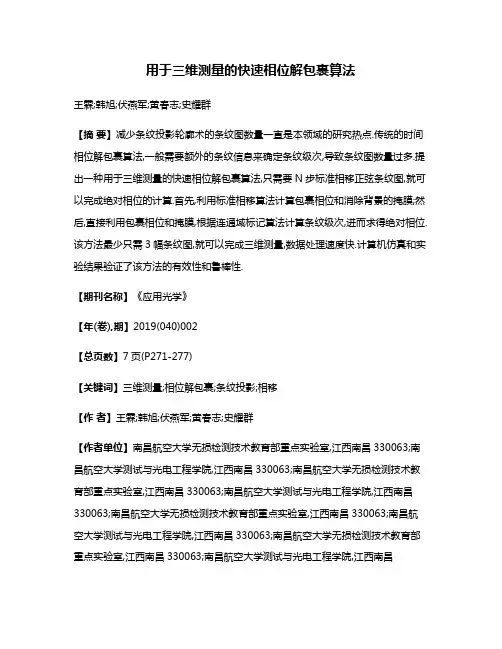
用于三维测量的快速相位解包裹算法王霖;韩旭;伏燕军;黄春志;史耀群【摘要】减少条纹投影轮廓术的条纹图数量一直是本领域的研究热点.传统的时间相位解包裹算法,一般需要额外的条纹信息来确定条纹级次,导致条纹图数量过多.提出一种用于三维测量的快速相位解包裹算法,只需要N步标准相移正弦条纹图,就可以完成绝对相位的计算.首先,利用标准相移算法计算包裹相位和消除背景的掩膜;然后,直接利用包裹相位和掩膜,根据连通域标记算法计算条纹级次,进而求得绝对相位.该方法最少只需3幅条纹图,就可以完成三维测量,数据处理速度快.计算机仿真和实验结果验证了该方法的有效性和鲁棒性.【期刊名称】《应用光学》【年(卷),期】2019(040)002【总页数】7页(P271-277)【关键词】三维测量;相位解包裹;条纹投影;相移【作者】王霖;韩旭;伏燕军;黄春志;史耀群【作者单位】南昌航空大学无损检测技术教育部重点实验室,江西南昌330063;南昌航空大学测试与光电工程学院,江西南昌330063;南昌航空大学无损检测技术教育部重点实验室,江西南昌330063;南昌航空大学测试与光电工程学院,江西南昌330063;南昌航空大学无损检测技术教育部重点实验室,江西南昌330063;南昌航空大学测试与光电工程学院,江西南昌330063;南昌航空大学无损检测技术教育部重点实验室,江西南昌330063;南昌航空大学测试与光电工程学院,江西南昌330063;南昌航空大学无损检测技术教育部重点实验室,江西南昌330063;南昌航空大学测试与光电工程学院,江西南昌330063【正文语种】中文【中图分类】TN29;TP274引言条纹投影三维测量方法,又称条纹投影轮廓术(FPP),具有非接触、低成本、高精度和高效率的优点,因此被广泛应用在三维测量中[1-4]。
通过投影仪将条纹投影到被测物体表面,条纹由于受物体高度的调制发生变形。
相机采集变形的条纹图像,然后通过计算机对其进行处理,解调出物体高度的相位信息,再结合系统标定参数获得物体的三维高度信息[1-2]。
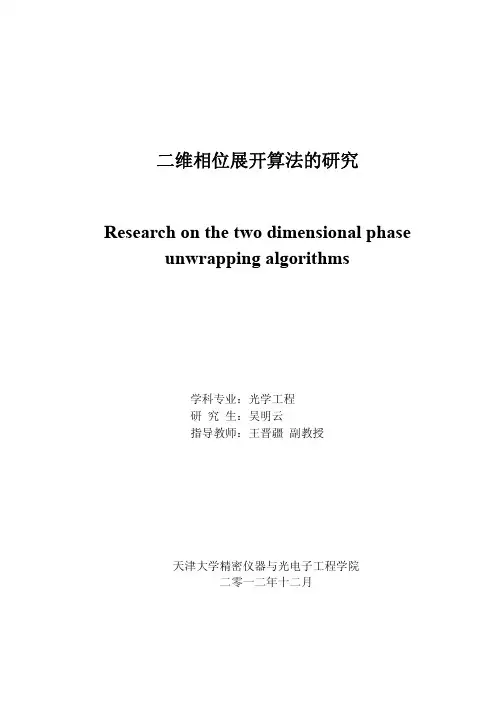
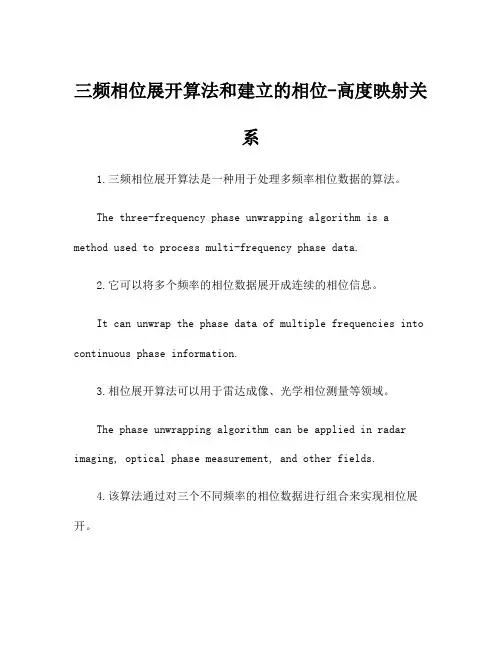
三频相位展开算法和建立的相位-高度映射关系1.三频相位展开算法是一种用于处理多频率相位数据的算法。
The three-frequency phase unwrapping algorithm is a method used to process multi-frequency phase data.2.它可以将多个频率的相位数据展开成连续的相位信息。
It can unwrap the phase data of multiple frequencies into continuous phase information.3.相位展开算法可以用于雷达成像、光学相位测量等领域。
The phase unwrapping algorithm can be applied in radar imaging, optical phase measurement, and other fields.4.该算法通过对三个不同频率的相位数据进行组合来实现相位展开。
The algorithm achieves phase unwrapping by combiningphase data from three different frequencies.5.其原理是利用三个频率之间的相位差异来消除相位不连续。
The principle is to use the phase differences betweenthree frequencies to eliminate phase discontinuities.6.在相位-高度映射关系中,相位对应于信号传播的距离或高度。
In the phase-height mapping relationship, the phase corresponds to the distance or height of signal propagation.7.高度测量技术常常利用相位-高度映射来实现对目标高度的测量。

Electronic Technology •电子技术Electronic Technology & Software Engineering 电子技术与软件工程• 109【关键词】相位展开 枝切法质量图 最小二乘法相位轮廓测量术(Phase Measuring Profilometry,PMP )是一种面结构光测量技术,具有非接触式、精度高和速度快等优势,在三维视觉测量中有着广泛的应用。
在计算包裹相位时用到了反正切函数,得到的包裹相位的值被限制在(-π, π]之间,所以如何从间断的包裹相位值中恢复出真实的相位值,即相位展开是相位轮廓测量术的关键技术之一,相位展开的精度关系到三维重建的精度。
如果包裹相位图中没有噪声,满足Itoh 条件(展开相位图中相邻相位点的差分小于π)的条件时,采用相邻相位加减2π先展开行再展开列(或先展开列再展开行)的基本原理相位展开法,包裹相位图的每个点的相位都得到展开,就可以得到展开的二维相位图。
但在真实的测量环境中,被测物体表面存在反光、阴影、孔洞、断裂等噪声区域,有效像素被断开不再连续,噪声区域得不到正确的展开相位值,并且任意一点的相位展开错误都会沿着展开路径传播,造成“拉线”现象,相位展开的难度就体现在这些方面。
为了增加相位展开算法的抗干扰性,国内外不同领域的学者研究了很多算法,这些算法大致可以分为依赖于积分路径的局部算法和基于最小二乘法的全局算法。
Goldstein 枝切法是局部算法中比较经典的,通过识别包裹相位图中的正负残差点并在之间形成枝切线,相位改进枝切法在PMP 相位展开中的应用文/郭戈展开的路径需要避开枝切线,这样就不会造成由于积分路径不同而相位展开结果不一样的情况,避开残差点,误差没有累加,限制了误差的传播。
Goldstein 连接相邻最近残差点设置枝切线,该算法执行很快,但是在残差点密集的区域,枝切线容易自我封闭,在包裹相位图中形成“孤岛”,导致这部分区域无法解缠。
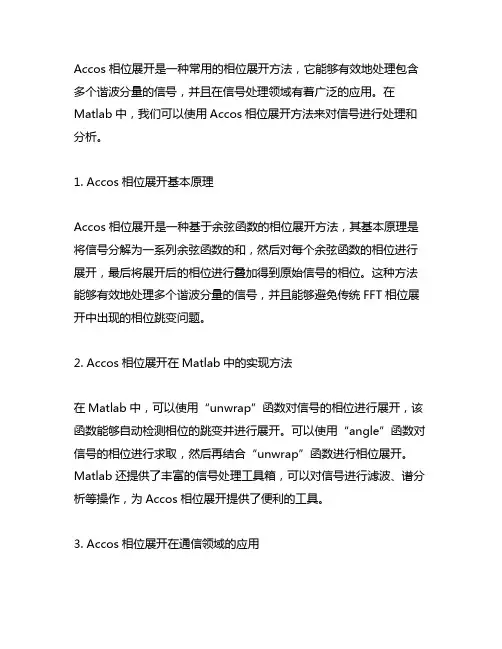
Accos相位展开是一种常用的相位展开方法,它能够有效地处理包含多个谐波分量的信号,并且在信号处理领域有着广泛的应用。
在Matlab中,我们可以使用Accos相位展开方法来对信号进行处理和分析。
1. Accos相位展开基本原理Accos相位展开是一种基于余弦函数的相位展开方法,其基本原理是将信号分解为一系列余弦函数的和,然后对每个余弦函数的相位进行展开,最后将展开后的相位进行叠加得到原始信号的相位。
这种方法能够有效地处理多个谐波分量的信号,并且能够避免传统FFT相位展开中出现的相位跳变问题。
2. Accos相位展开在Matlab中的实现方法在Matlab中,可以使用“unwrap”函数对信号的相位进行展开,该函数能够自动检测相位的跳变并进行展开。
可以使用“angle”函数对信号的相位进行求取,然后再结合“unwrap”函数进行相位展开。
Matlab还提供了丰富的信号处理工具箱,可以对信号进行滤波、谱分析等操作,为Accos相位展开提供了便利的工具。
3. Accos相位展开在通信领域的应用Accos相位展开在通信领域有着广泛的应用,它能够有效地处理复杂多谐波信号,并且能够提高通信系统的性能。
在OFDM系统中,Accos相位展开能够减小系统的误码率,提高系统的抗干扰性能。
在频谱分析、信号检测等方面也都有着重要的应用价值。
4. Accos相位展开在雷达信号处理中的应用Accos相位展开也在雷达信号处理中有着重要的应用,它能够处理雷达回波中的多个目标的相位信息,并且能够对目标进行精确定位和跟踪。
在雷达信号处理中,Accos相位展开能够提高信号的分辨率,并且能够准确地估计目标的速度和方向。
5. 结语Accos相位展开是一种常用的相位展开方法,在Matlab中能够方便地实现和应用。
它在通信、雷达等领域有着广泛的应用,能够提高信号处理的精度和效率。
深入研究和应用Accos相位展开方法对于提高信号处理的水平具有重要的意义。

相位解和平均相位-概述说明以及解释1.引言1.1 概述相位解和平均相位是信号处理领域中重要的概念。
相位解是指从信号中提取出的相位信息,它可以揭示信号的周期性和频率特征。
相位解的应用广泛,包括音频处理、图像处理、通信系统等领域。
平均相位是指多个相位解的平均值,它可以用来衡量信号的整体相位特征。
平均相位的计算方法多种多样,常见的有加权平均法和基于统计方法的平均法。
相位解和平均相位在信号处理中起着重要的作用,对于理解信号的周期性和频率特征,以及改善信号处理的效果具有重要意义。
本文将从定义和解释相位解、平均相位开始,介绍它们的应用和计算方法,并总结它们的重要性。
最后,还将讨论未来研究的方向,以期进一步推动相位解和平均相位在信号处理领域的应用和发展。
1.2文章结构文章结构部分的内容可以按照以下方式进行编写:文章结构:本文将分为三个主要部分,分别是引言、正文和结论。
1. 引言:引言部分将概述本文要讨论的主题,即相位解和平均相位。
首先,我们会简要介绍相位解和平均相位的概念,并解释它们在各个领域中的应用。
然后,我们将介绍本文的结构和目的,以便读者对本文的内容有一个整体的了解。
2. 正文:正文部分将详细讨论相位解和平均相位。
首先,我们会对相位解进行定义和解释,明确其在信号处理、通信系统和图像处理等领域中的重要性。
然后,我们将探讨相位解的应用,例如在图像重建、声纹识别和图像处理中的实际应用案例。
接下来,我们将引入平均相位的概念,并解释其在信号处理和光学等领域中的作用。
随后,我们将介绍计算平均相位的方法,包括加权平均法和统计方法等,并说明它们的优缺点以及适用范围。
3. 结论:结论部分将对本文所讨论的内容进行总结,并强调相位解和平均相位的重要性。
我们会回顾相位解和平均相位在不同领域中的实际应用,并讨论它们对相关研究领域的未来发展的影响。
此外,我们还将提出一些可能的未来研究方向,以便读者在深入研究相位解和平均相位的基础上开展更多的探索和应用。

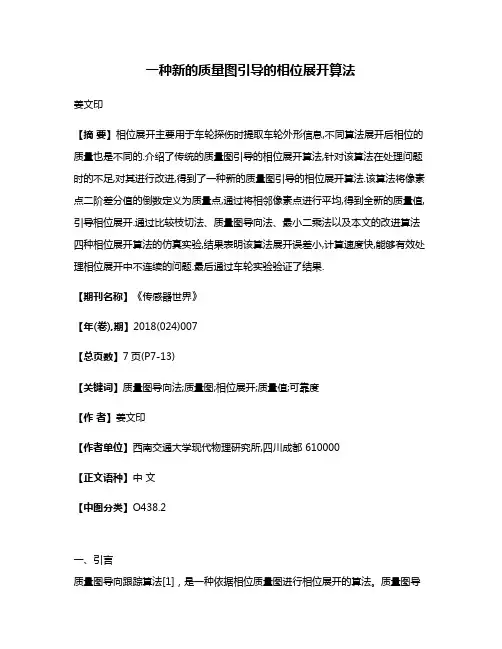
一种新的质量图引导的相位展开算法姜文印【摘要】相位展开主要用于车轮探伤时提取车轮外形信息,不同算法展开后相位的质量也是不同的.介绍了传统的质量图引导的相位展开算法,针对该算法在处理问题时的不足,对其进行改进,得到了一种新的质量图引导的相位展开算法.该算法将像素点二阶差分值的倒数定义为质量点,通过将相邻像素点进行平均,得到全新的质量值,引导相位展开.通过比较枝切法、质量图导向法、最小二乘法以及本文的改进算法四种相位展开算法的仿真实验,结果表明该算法展开误差小,计算速度快,能够有效处理相位展开中不连续的问题.最后通过车轮实验验证了结果.【期刊名称】《传感器世界》【年(卷),期】2018(024)007【总页数】7页(P7-13)【关键词】质量图导向法;质量图;相位展开;质量值;可靠度【作者】姜文印【作者单位】西南交通大学现代物理研究所,四川成都 610000【正文语种】中文【中图分类】O438.2一、引言质量图导向跟踪算法[1],是一种依据相位质量图进行相位展开的算法。
质量图导向法的根本是进行像素扩散,利用一个表征相位质量的质量图来引导相位展开。
质量图导向法的重要部分是质量图,质量图的好坏直接影响着该算法的展开结果。
1991年,Bone提出用包裹相位数据的二阶差分作为质量图[2];Xu和Ai使用干涉测量得到的干涉条纹的调制度作为质量导引依据[3];后来Xu和Cumming使用IFSAR数据中的相关系数作为质量图指导IFSAR数据的展开[4];2005年,Herraez等提出了基于合并聚类的质量引导算法[5]。
本文针对已经获得的质量图展开工作,探索包裹相位图在解包裹过程中,不同的积分路径对于结果的影响。
通过探索,找到了新的解包裹路径。
利用质量图上各个像素点二阶差分值的倒数来表征质量值,根据质量值进行相位展开。
该方法可以大大缩短计算时间,同时提高计算结果,符合预期的要求。
二、基本原理1、传统质量引导算法质量图导向法的基本操作流程如下[6-7]:(1)从质量高的像素点出发,然后检查这个像元点附近的4个像素点,然后对这4个像素点进行相位展开,相位解缠;(2)将进行了相位解缠的临近像元周围的像素(未进行相位解缠)储存到“邻接列”中;(3)根据相位的质量图,从“邻接列”中选出质量高的像素进行解缠,并更新这一列;(4)重复(1)、(2)步骤,直至所有相位解缠完毕。
相位展开的6种算法比较杨锋涛;罗江龙;刘志强;吕晓旭【摘要】相位展开算法主要可以分为路径跟踪算法和全局展开算法.为了比较这些算法的性能,采用计算机模拟斜面和高斯面,并加入不同程度噪声产生包裹相位;从两大类中各选取3种比较典型的算法分别对其进行相位展开,计算它们的均方根误差;最后对实验数据进行比较和理论分析.结果表明,基于网络规划的最小费用流算法和基于贝叶斯推断的ZπM算法是较为有效的算法,在实际应用中值得选择和改进.【期刊名称】《激光技术》【年(卷),期】2008(032)003【总页数】4页(P323-326)【关键词】信息光学;相位展开;算法比较;计算机模拟【作者】杨锋涛;罗江龙;刘志强;吕晓旭【作者单位】九江学院,理学院,九江,332005;九江学院,理学院,九江,332005;九江学院,理学院,九江,332005;华南师范大学,信息光电子科技学院,广州,510631【正文语种】中文【中图分类】O438引言二维相位展开是从包裹相位ψ中恢复出原始相位φ信息的技术。
随着光学干涉计量技术(散斑干涉、全息干涉、莫尔干涉等),磁共振成像技术,尤其是合成孔径雷达干涉技术的发展和应用,相位展开技术逐渐成为了一项重要的技术,引起了人们广泛的重视。
对于理想的包裹相位图,只要利用ITOH[1]提出的方法对包裹相位梯度进行线积分即可,但是实际得到的包裹相位图却可能包含噪声、阴影,以及欠采样等,致使相位展开问题变得非常困难。
近20年来,各种相位展开的算法层出不穷,各种算法的优劣和适用条件都有待于进一步的考察。
总体上说,这些算法可以分为两大主流。
一类是路径跟踪算法,通过某些途径,如设置枝切或建立质量图,以质量图为导向等,寻找合适的积分路径来进行相位展开。
这类算法中有代表性的主要有:枝切法[2-3],质量图导向法[4-5]和基于网络规划的最小费用流算法[6-7]。
另一类是全局展开算法,通过引入目标函数,并附以一定的约束条件,将相位展开问题转化为求解最优化的问题。
相位阵列天线技术的研究与应用1、引言在现如今科技发展飞速的时代,技术的创新和应用是推动社会进步的重要动力之一。
其中,在通信技术领域的发展也是不断逐步精进的,各种新型通信技术层出不穷。
其中,相位阵列天线(PA)技术是现代通信技术中极为重要的一种,本文将从介绍与原理、PA技术应用等方面进行探讨。
2、相位阵列天线(PA)技术原理相位阵列天线技术,英文名称为Phased Array,是一种通过改变天线的相位实现高效辐射的技术。
它可以在不应用机械操作的情况下,实现电子扫描和电子开关等功能。
PA技术的组成主要是由多个阵列组合而成的,每个阵列通过程序控制,可以实现相位控制电路的驱动,实现对天线束的调整。
PA天线系统的主要部分包含有天线、信号处理模块和控制装置。
其中,天线部分的主要作用是负责接收和发射信号,信号处理模块则包括了A/D转换、数字信号处理等。
控制装置主要负责控制阵列天线执行各种操作。
通过上述的三部分组成, PA天线系统所实现的功能包括相位补偿、电子归零和频率跳变等多种功能,具有调制复杂度低、覆盖面积广、功耗低等优点。
3、 PA技术的应用PA技术广泛应用于通信和雷达系统中,通过其可以实现更加远距离与更低功率的信号传输,随着卫星、飞机、自行车等物体的发展, PA技术在实际中的应用也越来越广泛。
3.1 PA技术在天线领域中的应用PA技术在天线领域中的应用尤为显著。
在卫星领域中, PA技术具有更高的性能,可以实现信号的深度变化同时保持其带宽,是一个优秀的天线选择。
在雷达领域, PA天线可以实现场景图像获取,同时对多个目标进行跟踪和定位。
在通信领域中, PA技术也能够实现更加远距离与更低功率的信号传输,是一个非常适合局域网技术的选择。
3.2 PA技术在人类生活中的应用PA技术在人类生活中的应用也非常广泛。
例如,相位阵列天线技术是基于空间器,这种技术能在卡车大型汽车中,构建前摄像头的硬件系统的聚焦方向,并且通过软件进行强制重建。